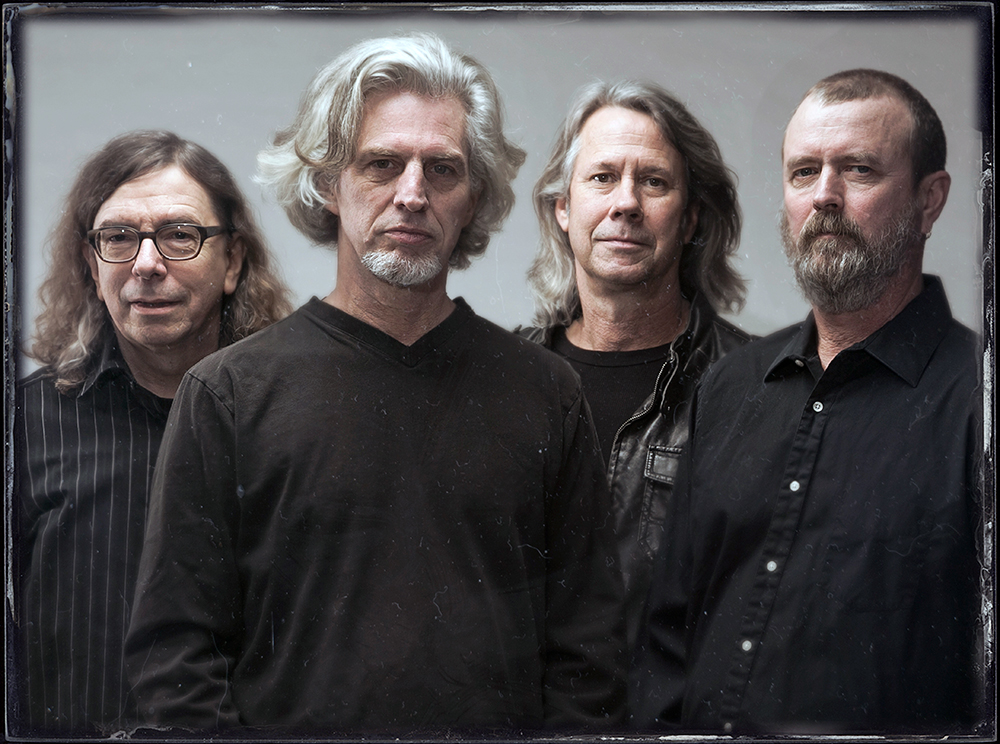
Bob Walkenhorst joined the Kansas City music community in the early 1980s, first as part of the trio Steve, Bob & Rich, then as frontman for the Rainmakers, who would attract some national attention in the mid to late 1980s.
Nearly 40 years later, the Rainmakers are still active, and so is Walkenhorst. In addition to the band, he also performs solo and as a duo with fellow Rainmaker Jeff Porter. He is also part of a music project with his daughter, Una Walkenhorst.
This summer, the Rainmakers will travel to Norway—where they have been revered since the release of the first Rainmakers album in 1986—for a final performance. Walkenhorst recently answered questions from IN Kansas City about this farewell voyage, about his association with author Stephen King, and about a book of lyrics he will be publishing.
At the end of July, the Rainmakers will perform for the final time in Norway. Give us the history of the band with this country some 7,000 miles from Kansas City.
Our first show in Norway was in Oslo, Dec 20, 1986. It was the last date of our first European tour. Our album had only been out a couple weeks. We played London, Paris, Amsterdam—a day for two weeks. And no one had any idea who we were; reception was not strong.
The last date of the tour was Oslo, and we were so tired. We thought, “Let’s just get this over with and get home.” But we arrive at a sold-out venue, people mobbing the stage, singing along on every song. What the hell? We love this place!
It seems we had gotten a key review in their national music magazine, national radio had embraced us, and word of mouth did the rest. I’d guess between 1986 and 1997 we played there a hundred times, all over the country, top to bottom. They tell us we have seen more of Norway than most Norwegians. Since our reunion in 2011, we’ve done ten two-week tours.
Best memories? We’ve played many outdoor festivals in the short, beautiful Norwegian summer. One time we had to follow Midnight Oil, and we actually took it up a notch. One summer we did five dates with Leonard Cohen, which may seem like a strange match-up. One night Leonard would play first, next night we would play first. I told Leonard I marveled at the way he held the crowd in rapt silence. He said he wished that just once they could come out and f***ing rock, like we did.
But the winter tours were magical. Long train trips across snowy mountains. Small towns where weekends were crazy. We’ve played way north of the Arctic Circle. We’ve seen both the midnight sun and the midday dark. We’ve made so many good friends and had time to get to know their history and culture.
I can’t really say there is a big difference in the Norwegian audience and the American audience. The songs took hold because they resonated with common experiences of coming of age, dealing with the real world, trying to find some humor in there somewhere. I do think the Norwegian fans found us to be peculiarly “American.” They took great interest in the lyrics, the language, the slang and cultural references.
Concurrently, you will release a limited-edition compilation of your lyrics. Some well-known names will be associated with this. Tell us about it.
So we’re going to do this farewell show in July. And I feel pretty safe in saying this really will be “farewell.” Our friends who are sponsoring and organizing the show, which will be on a farm in a fairly rural area, really wanted this to be an event, or a series of events, rather than just a single show. So we’ll do a Rainmakers acoustic show for the sponsors, a Walkenhorst & Porter show one night. And I am going to have a discussion/forum with two Norwegian authors about words/lyrics—the writing process. They both grew up on our music, so it should be fun and interesting, if a bit self-conscious on my part.
Somewhere along the line of organizing this authors’ event, the idea came up to do a book of my song lyrics. A limited-edition to be featured at this event. These authors—Lars Mytting (The 16 Trees of the Somme) and Levi Henriksen (Snow Will Fall on Fallen Snow)—offered to write some introductions. I found out later that requests had also been sent out to Jo Nesbø (The Snowman, The Thirst, The Redbreast, Headhunters) and just one American author.
Even though he has a reputation for being an impossible guy to get hold of, Stephen King responded immediately with a very nice intro paragraph for the lyrics book. I was humbly surprised. So Lars and Levi ended up writing several pages of their memories of growing up with the Rainmakers. Then, another crazy surprise, Jo Nesbø informs us that, rather than an intro paragraph, he will submit an unpublished short story loosely based on a couple Rainmakers songs. I think I may be upstaged in my own book!
Talk about your relationship with Stephen King. Does it go beyond fandom/mutual respect?
In January of 1987, King hired us to come play in Bangor, a concert sponsored by the radio station he owned. We drove through a blizzard, played the show, met Stephen. This was still during his wild years; he was pretty intense. But he told us he was going to use some song lyrics in his upcoming books, and—whaddayaknow—he did. So we will always be in print! I corresponded with him a couple times, and he tweeted that he loved our Monster Movie album. It was good to know he was keeping up with us.
Lyrics have been elemental to your songs. Who are some writers and/or lyricists who have inspired or influenced you? What about their work do you admire or respect most?
Of course, the big ones: Dylan, Lennon/McCartney, John Fogerty, Paul Simon, Joni Mitchell. As I got serious about songwriting, it was the dark humor of Warren Zevon and Leonard Cohen that really intrigued me. I always admire a writer who doesn’t waste your time or isn’t afraid to take on a hard subject but can still make it entertaining, maybe even fun.
What are the Rainmakers plans after Norway? Is there new music ahead?
That’s a tough question. Actually, the tough question is: What do you do when you are a moderately successful band, you’ve worked hard to make meaningful music, but you can’t really do it full-time? Where does that leave you? I guess we do shows around K.C. now and then; I play with my daughter, Una; I play solo. We all have different projects to keep us busy and inspired. Other than that, don’t overthink it. Just keep playing.
My introduction to you was watching Steve Bob & Rich at the Jazzhaus in Lawrence back in 1984. What was that experience like and how did it abet the transition to the Rainmakers?
I arrived in KC in 1982. The music scene here was amazing. Great bands: Fools Face, the Secrets, the Morells, Kelly and the Kinetics, the Clocks, and a whole bunch of great cover bands.
Everybody was playing four or five nights a week, four hours a night. You could pay the rent, live well, and you got better at your craft, playing that much. It was a really good time to be a musician in KC. And there was kind of a road map on how to move forward. Play good covers, work in your original material, road test it, make an independent record, go shop it to the labels, get good press, get pro management and booking. And work! And we did.
We had some friends who moved to the coasts, hoping that would be good for their career. And that did work for some people. But we quickly realized that it didn’t much matter where you lived, as long as you were willing to get out on the road and tour relentlessly. So we stayed in KC.
You have started a music project with your daughter, Una. Talk about the adjustments you had to make not only working with another songwriter but with your offspring. What has she taught you?
Ha! It took me awhile to quit being “Dad” and “the voice of experience” and realize that Una was a unique writer and a strong singer, and I could learn a lot if I shut my mouth and opened my ears and mind to find a new way to create music.
Her instincts are more poetic than mine. I tend to look for the punchline, the impact moment. She is better at creating a trance, a mood. She’s not afraid to be subtle, which I am sometimes. And I’ve gotten to be the harmony singer! Which is way different than being the lead singer. You actually have to be more accurate, more controlled. It has been a joy and an unexpectedly deep musical experience to create and perform with her this past year.
You are also a visual artist, a painter, mostly of landscapes. When did you start painting? What does it provide, artistically, spiritually, and otherwise, that music doesn’t? Are there similar satisfactions between the two?
The obvious difference is that one is loud, and one is silent. Which to someone who has spent their life immersed in sound and noise, that silence is an important flipside. I actually went to college for visual arts, but during the band’s busy years, there was no time to paint. But during the last decade I have had time for both. Music in the summer, painting in the winter. It has made for a better balance in my life and in my head. The similar satisfaction is just that. You’re making something, and it’s always interesting to follow it to the end and see where it points. The difference: You always get to keep the song, and you get to sing it over and over. The painting goes away; you have to turn loose of it to complete the circuit.
View several years of Bob Walkenhorst’s paintings at rainmakers.com/bobs-paintings
Email Timothy Finn at tfinn@inkansascity.com

